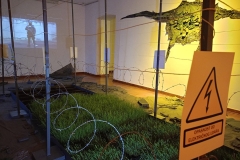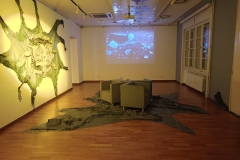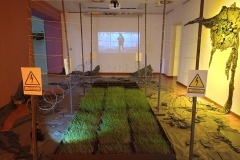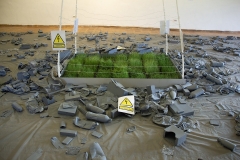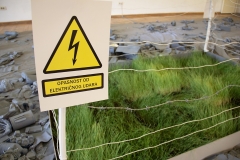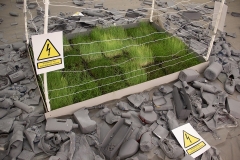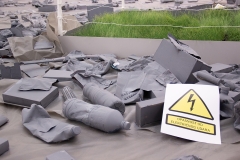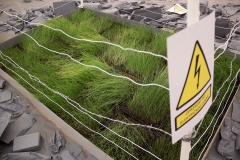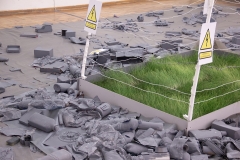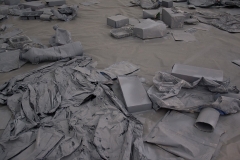The Garden of Earthly Delights or The Damned Yard
Anahata Transformation
The exhibition Transformation of the Anahata is a sequel to the project The Garden of Earthly Delights or the Damned Yard, presented at KC Grad in 2023. The exhibition unfolds in two parts: the first opens on September 3rd and runs until the 16th, when the second part takes over and remains on view until the end of the month.
At its core, the project critically reflects the ecological and social consequences of escalating hyper-production and consumption. These forces shape not only the state of the planet but also the fabric of human relationships. At the same time, the artwork addresses pressing social questions, confronting us with the urgent and often intractable challenges of our time. The central narrative running through Jana Stojaković’s series of paintings is here reimagined through AI animations. Class divisions are transposed into a post-human world in which people are genetically merged with animals according to economic status: the poorest as human-cockroaches, the middle class as human-rats, and the elite as human-wild boars. The animation Survival symbolically depicts the cruelty of these post-human hierarchies, with ecological collapse as their constant backdrop.
As in the earlier project, polluted and barren land is represented by waste. Here, however, the waste expands beyond the floor to the very walls of the gallery, taking on an almost organic form—growing uncontrollably, as the waste becomes an entity of its own. The “garden” is enclosed by barbed wire and electric fencing, containing corn, wheat, and soy—staple crops that symbolize the continents/powers of the Americas, Europe, and Asia. This points to deepened social divisions and conflicts over territory and resources, increasingly scarce and precious, as echoed in the current wars (Ukraine, Gaza).
A surveillance camera oversees the protected zone, inviting visitors to imagine themselves either as those kept outside—threatened with electric shock should they approach the fence—or as guards, monitoring and defending someone else’s property from behind the screen. Animated policeman, a human-rat, comes to the fore as representative of the repressive state and capital alliance, underscoring class inequality. Yet hunger inevitably emerges as the overarching theme—whether as a consequence of poverty, war, or climate disaster.
Ultimately, the work highlights the unavoidable interdependence of classes, while leaving open the possibility that “things could be arranged differently.” It is precisely the second part of the exhibition that gestures toward such a potential resolution. The title itself points to a transformation achievable only through the awakening of the heart chakra — the Anahata. It suggests the emergence of a form of empathy so radically different from the state we know today that it may rightly be described as “alien”.
The Garden of Earthly Delights or The Damned Yard
The name of the project “The Garden of Earthly Delights or The Damned Yard” combines titles of two artworks that marked different artistic fields. The painting “The Garden of Earthly Delights” is a part of the famous triptych by Hieronymus Bosch representing Eden, while the novel “The Damned Yard” by Ivo Andric depicts the isolation and restrictions of prison life.
The project is a depiction of a dystopia that the world is already rushing towards, facing the first signs of climate change, while catastrophic consequences await humanity in the very near future.
The polluted, barren land is represented through waste—the remnants of human civilization, which, through relentless hyper-production and consumption and the excessive exploitation of natural capacities, deadens everything in its path. According to Yuval Noah Harari (Sapiens: A Brief History of Humankind, Biblioner, Belgrade 2014, pp. 73–74), wheat is one of the most successful plants in all of history. Its cultivation began 10,000 years ago, and today it remains, to a large extent, the foundation of human nutrition. Enclosed by an electric fence and monitored by surveillance cameras, it points to new social divisions and struggles over the remaining, strictly guarded resources and territories suitable for life. According to Slavoj Žižek (Violence, Ljevak, Zagreb, May 2008, p. 29), those who are essentially responsible for creating a devastated and polluted world are fleeing from everything bad they have done, living in fenced communities, eating organic products, and spending vacations in nature reserves.
The audio moment—the frequency of the Earth (OM)—in this exhibition emphasizes the final phase of hyper-consumerist society, where the accumulated problems of pollution and depleted resources are not being resolved. Instead, the focus shifts to purchasing products that promise the ultimate goals of health, youth, and beauty. In this way, the vicious cycle of consumption only continues, sustained by the satisfaction of new, often fabricated, needs.

